 W
WAcasis appensata is a moth of the family Geometridae. It is found throughout most of the Palearctic realm.
 W
WAcleris rhombana, the rhomboid tortrix, is a moth of the family Tortricidae. It is found in the Palearctic realm, from Europe to the Caucasus, Armenia, and Turkmenistan.
 W
WAcleris variegana, the garden rose tortricid moth or fruit tortricid, is a moth of the family Tortricidae. It has a Palearctic distribution. The moth flies from July to September mainly at night and is attracted to bright lights. The larvae feed on various trees and shrubs including rose and apple.
 W
WActinotia polyodon, the purple cloud, is a moth of the family Noctuidae. It is found in much of the Palearctic realm, from Europe to Russia and Japan.
 W
WAdoxophyes orana, the summer fruit tortrix, is a moth of the family Tortricidae. It is found in the Palearctic realm and Taiwan.
 W
WAgriopis leucophaearia, the spring usher, is a moth of the family Geometridae. The species was first described by Michael Denis and Ignaz Schiffermüller in 1775. It is a Palearctic species found from Europe to the Russian Far East, Siberia and Japan.
 W
WAgrotis lasserrei is a moth of the family Noctuidae. It is widespread throughout most of the eremic zone of the Palearctic realm, from south-east Spain and the western part of the Sahara to Turkmenistan and Iran.
 W
WAgrotis vestigialis, the archer's dart, is a moth of the family Noctuidae. The species was first described by Johann Siegfried Hufnagel in 1766. It is found in most of the Palearctic realm from Ireland east, through to Russia, Siberia, the Altai mountains and the Amur region, and is also present in the Mediterranean Basin. It is absent from the north of Finland and Norway.
 W
WAmphipoea oculea, the ear moth, is a moth of the family Noctuidae. It was first described by Carl Linnaeus in 1761 and it is found in most of the Palearctic realm.
 W
WAnania coronata, the elderberry pearl, elder pearl or crowned phlyctaenia, is a species of moth of the family Crambidae. It was described by Johann Siegfried Hufnagel in 1767 and is found in the northern parts of the Palearctic realm. It was previously also listed for the Nearctic realm. The species closely resembles Anania stachydalis.
 W
WAncylis apicella is a moth of the family Tortricidae. It is found in the Palearctic realm.
 W
WAncylis badiana is a moth of the family Tortricidae. It is found in the Palearctic realm.
 W
WAntigius is a genus of butterflies in the family Lycaenidae. The species of this genus are found in the eastern Palearctic realm, as well as Taiwan and Myanmar.
 W
WApamea crenata, known as the clouded-bordered brindle, is a moth in the Noctuidae family. It is distributed throughout the Palearctic realm.
 W
WApamea scolopacina, the slender brindle, is a moth of the family Noctuidae. The species was first described by Eugenius Johann Christoph Esper in 1788. It is found across the Palearctic realm from central Europe to the Kuril Islands northeast of Japan.
 W
WArchips rosana, the rose tortrix, is a moth of the family Tortricidae. It is found in both the Palearctic and Nearctic realms.
 W
WBoloria titania, the Titania's fritillary or purple bog fritillary, is a butterfly of the subfamily Heliconiinae of the family Nymphalidae.
 W
WBuckleria paludum, the European sundew moth, is a moth of the family Pterophoridae first described by Philipp Christoph Zeller in 1839. It is found in Asia and Europe.
 W
WCyclophora pendularia, the dingy mocha, is a moth of the family Geometridae. The species was first described by Carl Alexander Clerck in 1759 and it can be found in the Palearctic realm.
 W
WDiaphora is a genus of tiger moths in the family Erebidae described by Stephens in 1827. The moths are found in the Palearctic region.
 W
WDiaphora mendica, the muslin moth, is a moth of the family Erebidae. It is found in the Palearctic realm east to Lake Baikal.
 W
WThe Essex emerald is a moth of the family Geometridae. The species was first described by Johan Christian Fabricius in 1787. It is distributed throughout the Palearctic region with records from many European countries. The British subspecies Thetidia smaragdaria maritima was last seen in 1991 in Kent and is now presumed extinct. In 2004 the moth was first recorded from Sweden.
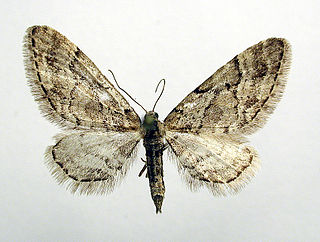 W
WEupithecia lanceata is a moth of the family Geometridae. It is known from most of the Palearctic realm, except for the south. The habitat consists of pine forests.
 W
WGlaucopsyche alexis, the green-underside blue, is a butterfly of the family Lycaenidae. It is found in the Palearctic.
 W
WGraphium alebion is a butterfly found in China that belongs to the swallowtail family.
 W
WThe green longhorn is a lepidopteran from the moth family Adelidae, the fairy longhorn moths.
 W
WThe heart and club is a moth of the family Noctuidae. It is distributed throughout the Palearctic realm.
 W
WHellinsia lienigianus is a moth of the family Pterophoridae which inhabits coastal areas, dry pastures and waste ground and is found in Africa, Asia, Australia and Europe. Also known as the mugwort plume it was first described by Philipp Christoph Zeller in 1852.
 W
WThe hornet moth or hornet clearwing is a large moth native to Europe and the Middle East and has been introduced to North America. Its protective coloration is an example of Batesian mimicry, as its similarity to a hornet makes it unappealing to predators. The hornet moth has been linked to the large dieback of poplar trees across Europe because its larvae bore into the trunk of the tree before re-emerging as adults.
 W
WLaspeyria flexula, the beautiful hook-tip, is a moth of the family Erebidae. The species was first described by Michael Denis and Ignaz Schiffermüller in 1775. It is found in the Palearctic realm.
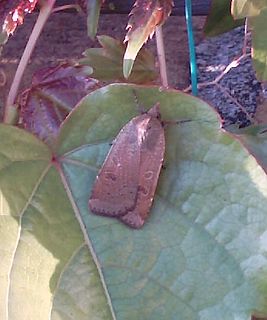 W
WThe lesser yellow underwing is a moth of the family Noctuidae.
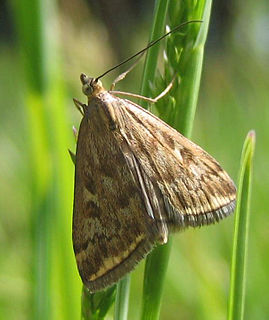 W
WLoxostege sticticalis is a species of moth of the family Crambidae. It was first described by Carl Linnaeus in 1761 and is found in the Palearctic and Nearctic realms.
 W
WMacaria liturata, the tawny-barred angle, is a moth of the family Geometridae. It was first described by Carl Alexander Clerck in 1759 and it is found throughout Europe.
 W
WMicropterix aureatella is a moth of the family Micropterigidae. It is found in the Palearctic realm, except North Africa.
 W
WMiltochrista miniata, the rosy footman, is a moth of the family Erebidae. The species was first described by Johann Reinhold Forster in 1771. It is found in the temperate parts of the Palearctic realm – Europe, Asia Minor, Caucasus, northern Kazakhstan, southern Siberia, Amur, Primorye, Sakhalin, southern Kuriles, Heilongjiang, Liaoning, Hebei, Inner Mongolia, Shanxi, Sichuan, Korea and Japan, but may be replaced by Miltochrista rosaria in the eastern Palearctic.
 W
WMniotype adusta, the dark brocade, is a moth of the family Noctuidae. It was described by Eugenius Johann Christoph Esper in 1790. It is found throughout much of the Palearctic from Europe to Japan, China and Mongolia. It is also found in North America. The habitat consists of heathland, chalky downland, fenland, moorland and upland areas.
 W
WThe Beautiful Arches (Mniotype satura) is a moth of the family Noctuidae. It is found in the Palearctic realm.
 W
WThe mullein moth,, is a noctuid moth with a Palearctic distribution.
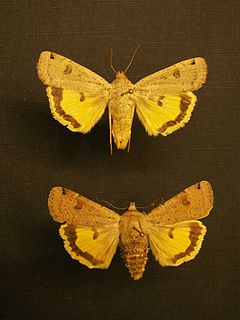 W
WNoctua orbona, the lunar yellow underwing, is a moth of the family Noctuoidea. It is found in the Palearctic.
 W
WThe November moth is a moth of the family Geometridae. The species was first described by Michael Denis and Ignaz Schiffermüller in 1775. It can be found in the Palearctic realm in western Europe from central Scandinavia to the Mediterranean the Caucasus and western Russia.
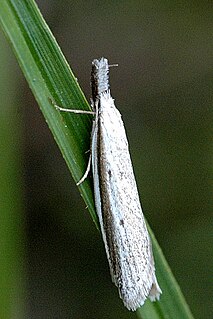 W
WPleurota bicostella is a moth of the family Oecophoridae. It is found in the Palearctic realm.
 W
WPtilophora plumigera, the plumed prominent, is a moth of the family Notodontidae. The species was first described by Michael Denis and Ignaz Schiffermüller in 1775. It is found in the southern parts of the Palearctic realm.
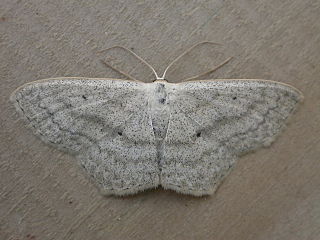 W
WScopula nigropunctata, the sub-angled wave, is a moth of the family Geometridae. It is found through most of the Palearctic realm.
 W
WSparganothis pilleriana is a moth of the family Tortricidae. It is found in the Palearctic realm.
 W
WSpilonota ocellana, the bud moth, is a moth of the family Tortricidae. It is found in the Palearctic realm, from North Africa and Europe to Iran, eastern Russia, China, Korea, and Japan. It is also present on Madeira and in North America.
 W
WSpilosoma urticae, the water ermine, is a moth of the family Erebidae. It is found in temperate belt of the Palearctic realm like similar Spilosoma lubricipedum, but prefers drier biotopes. So, S. urticae is more abundant in steppes and it is the single Spilosoma species in Central Asia.
 W
WTheretra alecto, the Levant hawk moth, is a moth of the family Sphingidae. The species was first described by Carl Linnaeus in his 1758 10th edition of Systema Naturae.
 W
WXanthorhoe abrasaria is a moth of the family Geometridae first described by Gottlieb August Wilhelm Herrich-Schäffer in 1856. It is found in the northern part of the Palearctic realm and the Nearctic realm.